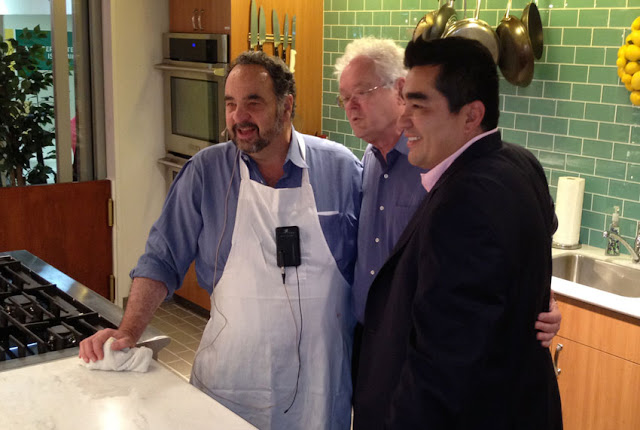 |
| Eran Wajswol |
What a Friend We Have in Cheeses
Wajswol, a late-comer to commercial cheese-making after a career as an engineer for nuclear power plant cooling systems, will be joining the list of market vendors this fall when he opens up his shop along Avenue D, where he'll not only sell and serve cheese (serving in the form of cheese paninis), but make it, too. He'll use cow milk from regional dairies (Delaware Valley College's and University of Pennsylvania's veterinary school are likely, but he's got others under consideration) to produce at least one cheese at the terminal, in full view of customers. "Reading Cheddar" will be his first cheese, but you won't be able to buy it for at least eight to twelve months after it's made: that's how long it will take to age in the market's basement where he'll have his aging room as well as milk storage tank. He's also considering making a Stilton-like cheese, and perhaps a fresh mozzarella.
 |
| Terrence Feury works salmon as Rick Nichols comments |
It's unfortunate that in the demonstrate Feury used a fish that's hard for the retail customer to come by: a salmon trout from Loch Duart in Scotland. This farm-raised fish is of superb quality, much better than the typical farm-raised Atlantic salmon. But it's impossible to find in fish stores, and exceedingly pricey even at the wholesale level. Even domestically raised salmon-trout, also known as steelhead, can be difficult (but not impossible) to find in retail stores in the Philadelphia area.
That said, Feury made a tasty dish that could easily be replicated, if not for the fish, at home. (I'd recommend doing it with Alaska king or sockeye salmon, now in season.) Cut a skinned filet into small serving pieces, about 2 ounces and lightly sprinkle with a mix of equal amounts of kosher salt and sugar, then let sit for about 20 minutes. The pieces then get very lightly sautéed in a lightly oiled pan (just warmed through, not cooked, hence the need for the best possible fish), then served with a lemon-oil emulsion (equal parts juice and olive oil, emulsified in the blender). He accompanied the fish with a melange of tiny cubes of cucumber, sun-dried tomato, in a sauce made with verjus and olive oil.
Yin and Feury's presentation was well attended, and among those watching was a Philadelphia restaurant luminary from the past: Kathleen Mulhern. She was another contributor to the city's restaurant renaissance in the 1970s with The Garden, which lasted from 1973 until early in the new millenium.
 |
| Jeremy Nolan makes sausage |
As Nolan operated the gleaming sausage stuffer, after mixing ground pork with appropriate seasonings to make bratwurst, Hager, born in northern Bavarian to an American father and German mother, poured the beer. And they weren't tiny samples, either! The beer and cooked brats were accompanied by a sauerkraut (based on imported German wine kraut, but doctored up by Nolan with beer, juniper berries and other seasonings), and German potato salad.
 |
| Anna Florio (left) and Aliza Green |
The centerpiece was handmade pappadelle pasta: she kept on saying how easy it was, but her kneading and rolling obviously required plenty of elbow grease, even if the technique was simple. Although she had semolina for dusting, the primary flour was Daisy, from a mill in Annville, Pennsylvania, which started in 1740. She said the low-protein, extra finely milled flour is ideal for pasta because it easily rolls out and results in soft, tender pasta that readily absorbs sauce or broth. While Green tended to the pasta, Florio worked wonders with zucchini (bought from Iovine's) in the sauté pan. The pasta was served with a simple olive oil sauce enlivened by garlic scapes.





















